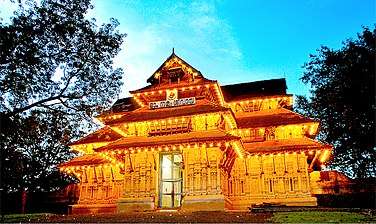Thrissur
Thrissur (![]()
Thrissur Trichur | |
|---|---|
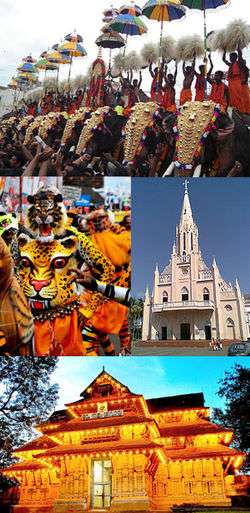 Clockwise from top: Thrissur Pooram, Our Lady of Lourdes Syro-Malabar Catholic Metropolitan Cathedral, Vadakkunnathan Temple, Puli Kali | |
 Thrissur  Thrissur | |
| Coordinates: 10.52°N 76.21°E | |
| Country | |
| State | Kerala |
| District | Thrissur District |
| Government | |
| • Type | Mayor–council government |
| • Body | Thrissur Municipal Corporation |
| • Mayor | Ajitha Vijayan (CPI) |
| • Deputy mayor | Beena Murali |
| • Police commissioner | Aadhithya R IPS |
| Area | |
| • Metropolis | 101.42 km2 (39.16 sq mi) |
| Elevation | 2.83 m (9.28 ft) |
| Population (2011)[2] | |
| • Metropolis | 315,596 |
| • Density | 3,100/km2 (8,100/sq mi) |
| • Metro | 1,854,783 |
| Demonym(s) |
|
| Languages | |
| • Official | Malayalam, English |
| Time zone | UTC+5:30 (IST) |
| PIN | 680XXX |
| Telephone code | Thrissur: 91-(0)487, Irinjalakuda: 91-(0)480, Wadakancherry: 91-(0)4884, Kunnamkulam: 91-(0)4885 |
| Vehicle registration | KL-08 |
| Coastline | 0 kilometres (0 mi) |
| Literacy | 97.24% |
| web portal | |
| Importance | Gold capital of India, Cultural capital of Kerala |
| Climate | Am/Aw (Köppen) |
| Precipitation | 3,100 millimetres (120 in) |
| Avg. summer temperature | 35 °C (95 °F) |
| Avg. winter temperature | 20 °C (68 °F) |
The city is built around a 65-acre (26 ha) hillock called the Thekkinkadu Maidan which seats the Vadakkumnathan temple. It is located 268 kilometres (167 mi) towards north-west of the state capital city Trivandrum.
Thrissur was once the capital of the Kingdom of Cochin.
Thrissur is known as "cultural capital of Kerala" the because of its cultural, spiritual and religious leanings throughout history.[5] One of its main cultural events is the Thrissur Pooram, which attracts quite a number of tourists and travellers.[6]
Etymology
The name Thrissur (Malayalam: തൃശ്ശൂര്) is a shortened form Tamil / Malayalam word Thiru-Shiva-Per-Ur (Malayalam: തിരു-ശിവ-പേര്-ഊര്, Lord-Shiva-Name-Town) literally translates to 'A Big City or Town with the three places of worship of the "Lord Shiva"'. The name owes itself to the most prominent feature of the city, that is the Vadakkumnathan Temple, which has Shiva as its presiding deity.[7] Alternately, Thri-Shiva-Perur (Malayalam: ത്രി-ശിവ-പേരൂർ, Three-Shiva-Palace) means the place with three Shiva temples which are said to be – the Vadakkumnathan Temple, Kottapuram Shiva temple and the Poonkunnam Siva Temple. Thrissur was known by its anglicised name Trichur until 1990, when the government decided to replace it with its Malayalam name. Thrissur was also known as "Vrishabhadripuram" (Kailasam of the South) in ancient days.[8]
Cultural and Business Significance
Thrissur is also known as the Cultural Capital of Kerala because of its cultural, spiritual and religious leanings throughout history.[9] It contains the Kerala Sangeetha Nadaka Academy, Kerala Lalithakala Akademi and Kerala Sahitya Academy.[10] The city hosts the Thrissur Pooram festival, the most colourful and spectacular temple festival in Kerala.[11][12] The festival is held at the Thekkinkadu Maidan in April or May, in the Malayalam month 'medam'.[9] Thrissur has a large number of well-known temples including the Vadakkumnathan temple, Thiruvambadi Sri Krishna Temple and Paramekkavu temple, and the Guruvayur temple as well as two churches, the Our Lady of Lourdes Syro-Malabar Catholic Metropolitan Cathedral and the Our Lady of Dolours Syro-Malabar Catholic Basilica, the largest Christian church in India.[13]
Thrissur has historically been a centre of Hindu scholarship. The city has one of the most important temples of Hindu Shaivism, that is the Vadakunnathan temple. The district is also home of one of the most holiest Hindu Vaishnava temples, the Guruvayur temple. Christianity, Islam and Judaism entered into the Indian subcontinent through the Thrissur District. The works of scholars and Eastern Christian writings claim Thomas the Apostle to have set foot in Muziris near Thrissur 2,000 years ago, established two churches one in Kodungaloor and the second in Palayoor which were the oldest in Asia (AD 51–52)[14][15] India's first mosque, Cheraman Juma Masjid, opened in AD 629.[16][17][17][18][19][20] Thrissur has opened the gates for Arabs, Romans, Portuguese, Dutch and English. Compared to other districts, Thrissur probably has the most number of temples .
The city has served as an incubator for many Malayali entrepreneurs,[21] and is a major financial and commercial hub of Kerala. There are many prominent Malayali business groups from Thrissur like the owners of Kalyan Jewellers, Joy Alukkas, Lulu etc.[22] It flexes its economic muscle in India as the headquarters of four major scheduled banks, South Indian Bank Ltd, Catholic Syrian Bank, Dhanalakshmi Bank and ESAF Small Finance Bank[23] Ltd and a clutch of Chit funds.[24] The city is also a big centre for shopping in Kerala for silks and gold jewellery. Thrissur attracts the largest number of domestic tourists in Kerala.[25]
Apart from being the cultural nerve centre of Kerala, it is also a major academic hub and is home to several educational institutions including the Kerala Kalamandalam, Kerala Agricultural University, Kerala University of Health Sciences, St Thomas College which is more than a century old, Jawahar Bal Bhavan Thrissur, Kerala Police Academy, College of Veterinary and Animal Sciences, Kerala Institute of Local Administration and Kerala Forest Research Institute.[26][27][28]

History
Pre-history
[29] The Ramavarmapuram monument is in granite and is of the menhir type. The monument in Ramavarmapuram is 15 feet (4.6 m) in height and 12 feet 4 inches (3.76 m) wide. Since 1944, it has been protected by the Department of Archaeology. The monument is locally known as Padakkallu or Pulachikkallu. These menhirs are memorials put up at burial sites for the departed souls. They belong to the Megalithic Age of Kerala, which is roughly estimated between 1000 BCE and 500 CE.[30] All such monuments have not been dated exactly. Some experts are of the view that these are the remnants of the Neolithic Age in the development of human technology. The Ramavarmapuram menhir is also believed to be a monument belonging to the Sangam period in the South Indian history.[31]
Another monolithic monuments like Dolmens and rock-cut caves are at Porkulam, Chiramanengad, Eyyal, Kattakambal and Kakkad. According to historians, the dolmens are burial sites. Though most of the monuments were well protected, the dolmen at Porkulam was in a neglected condition. The monument excavated under eminent Archaeologist B. K. Thapar, between 1949 and 1950, was under the Department of Archaeology.[29] Another megalithic monument is situated at Ariyannur in Thrissur. This place has unravelled monuments such as the Kudakkallu or Thoppikkallu (Mushroom stones or Umbrella stones) and 'Munimada' (Saint's abode).[32] The laterite hillocks of Ariyannur rise to about 50 metres. Another reference in Ariyannur dates back to the early 15th century in the poem Chandrotsavam.[32]
Pre-colonial history
The region can claim to have played a significant part in fostering the trade relations between Kerala and the outside world in the ancient and medieval period. The early political history of Thrissur is interlinked with that of the Chera Dynasty of the Sangam age, who ruled over vast portions of Kerala and Tamil Nadu. After the Cheras, the place was later ruled by the Kingdom of Cochin (Perumpadapu Swaroopam). Later, a powerful dynasty known as Zamorins of Calicut captured most of the Thrissur in 14th and 15th century.
Colonial period
Next was the turn of Portuguese who ruled Thrissur in the 16th century. In the beginning of the 17th century the Portuguese power was reduced and Dutch became the main power. With the help of Dutch, Cochin Royal Family recaptured Thrissur from Samoothiri in 1710.[33]
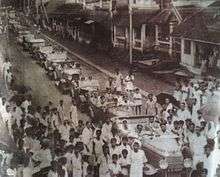
The modern City of Thrissur rose to importance after Sakthan Thampuran ascended the throne of Kingdom of Cochin (1769–1805). He changed the capital of Cochin Royal Family to Thrissur from Mattancherry and abolished the power of Namboothiri community, which controlled most of the temples of Thrissur district. The maharaja destroyed the forest around the Thekkinkadu Maidan which seats the Vadakkumnathan temple, and started the most spectacular cultural festival called Thrissur Pooram. Sakthan Thampuran laid the modern foundation stone of Thrissur and made the city into a major financial and commercial hub of South India, by inviting Syrian Christian families and Brahmins from adjoining areas.[33]
However, during 1750–60 Hyder Ali, the Sultan of Mysore, attacked Thrissur and became tributary of the Kingdom of Mysore. Tipu Sultan, his son led another invasion in 1786 to Thrissur, where he destroyed the churches of Syrian Malabar Nasrani community and Hindu temples. Tipu Sultan's Army set fire to the church at Palayoor and attacked the Ollur church.[34] The economy of Thrissur totally collapsed because of this invasion.[35] Later he made a retreat from Thrissur, which served as the headquarters of Kerala region, after the Srirangapattanam war. In the meantime, Rama Varma X, the successor of Sakthan Thampuran signed a treaty with East Indian Company, and made Cochin a subsidiary of the British.
Anti-Colonial movements
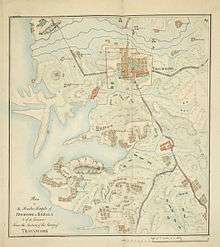
The Indian freedom movement struggle also grew in momentum in Thrissur after a Committee was formed in 1919 of the Indian National Congress. In 1921, the Civil Disobedience Movement also attracted a large number of people into the freedom struggle. In 1927 Mahatma Gandhi visited Vivekodayam School in the city.[36] In 1934, father of the nation, again visited the city for the housewarming of Barrister Krishna Menon. The house afterwards was known "Gandhi Mandiram" in Chembukkavu.[37] In the meantime, R. K. Shanmukham Chetty, the controversial Diwan of Cochin Kingdom from 1935 to 1941, developed the city by constructing Thrissur Town Hall and Ramanilayam. Even now these two buildings remain important in Kerala politics. Dr. M. R. Menon, a minister in Government of Kochi was instrumental in building the Municipal Corporation Building, Thrissur and the Municipal Office Road. He concreted Swaraj Round and other peripheral roads of the city.[38][39]
Post-Colonial
In 1947, when India gained independence from the British rule, Thrissur was under Kingdom of Cochin. Thrissur district was formed on 1 July 1949, with the headquarters at Thrissur City. The city is usually referred to as the Cultural Capital of Kerala. The city had been home to politicians and bureaucrats like R. K. Shanmukham Chetty, P.C. Rao, C. Achutha Menon, K. Karunakaran, Joseph Mundassery, Vinod Rai etc. after the independence. These individuals have changed the trajectory of Thrissur City afterwards.
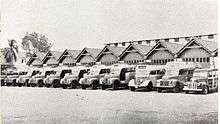
.
P.S. Rao, advisor to the Rajapramukh and acting Governor of Kerala, is another person who Thrissukkar is indebted to. He expanded Thrissur City by shifting all the administrative and government offices like Thrissur Collectorate to Ayyanthole from Chembukavu.[38] Government Engineering College, Thrissur, is another gift from Joseph Mundassery, the controversial former education minister who introduced Kerala Education Act. C. Achutha Menon, the former Chief Minister of Kerala gifted Kerala Agricultural University in 1971, a university for all agricultural related activities.[38]
K. Karunakaran, the Bhishma of Kerala politics started his career in Thrissur as a painter. Later on he became the "Leader" of city. During his regime Thrissur-Guruvayur Section and Poonkunnam Over Bridge was built.[40][41] Vinod Rai, the Comptroller and Auditor General of India, is another person who turned fortunes of the city by building Sakthan Thampuran Nagar (S.T.Nagar) when he was collector of Thrissur district. He is also known as the second Sakthan Thampuran of Thrissur by shifting the Municipal Stand near the M.O. Road to Shaktan Thampuran Nagar, now known as Shaktan Thampuran Private Bus Stand, Thrissur.[42] Another IAS officer who made remarkable contributions to the development of Trichur is Raju Narayana Swamy. He single-handedly widened five roads of the city- Pattalom Road, Inner Ring Road, Ragam Theatre Road, Padinjare Kotta and Chemputti Lane – thereby changing the face of the town.
Geography
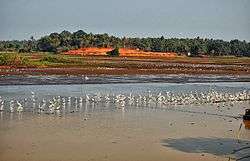
The city of Thrissur is situated in Thrissur District of Central Kerala in India. The city is located at 10.52°N 76.21°E and has an average altitude of 2.83 metres. The city is 75 km north-east of Kochi, 133 km south-west of Coimbatore , 124 km south-east of Kozhikode and 151 km north of Changanacherry.[43] The city is located in a hillock called Thekkinkadu Maidan which is the second highest point in city after the Vilangan Hills. From the hillock, the geography of the city move towards middle land where Thrissur Kole Wetlands is situated. The Kole Wetlands act as a natural drainage for the city where the water is carried out to river and from there to the Laccadive Sea, thus keeping Thrissur city safe from flood waters which affect most of the other cities in Kerala. [44][45][46][47] Different ponds, rivers and canals also keep the ground water safe from salt waters. The city is located in midland regions of Kerala, with an extended part of Palakkad plains.[48] The city geologically is composed of Archaean gneisses and crystalline schists. Major parts of city is covered by Archaeans rocks.[49] The city lies near the centre of the Indian tectonic plate (the Indian Plate) and is subject to comparatively little seismic or volcanic activity.
Climate
Under the Köppen climate classification, City of Thrissur features a Tropical monsoon climate. Summer lasts from March to May which is the hottest time of the year. Summer months are uncomfortable due to higher levels of heat and humidity. Daytime temperatures can rise up to 36 to 38 °C coupled with excessive humidity. Summer is followed by the South-west monsoon from June to September. October and November form the post monsoon or retreating monsoon season. Winter from December through February is cooler, and windy, due to winds from the Western Ghats. Winter months are generally dry and less humid compared to other months of the year. Morning temperatures are usually cool and daytime temperatures hover around 30 °C.[50]
The city is drained in the monsoonal season by heavy showers. The average annual rainfall is 300 cm. The South-west monsoon generally sets in during the last week of May. After July the rainfall decreases. On an average, there are 124 rainy days in a year. The maximum average temperature of the city in the summer season is 36 °C while the minimum temperature recorded is 27 °C. The winter season records a maximum average of 31 °C and a minimum average of 20 °C.[50]
| Climate data for Thrissur | |||||||||||||
|---|---|---|---|---|---|---|---|---|---|---|---|---|---|
| Month | Jan | Feb | Mar | Apr | May | Jun | Jul | Aug | Sep | Oct | Nov | Dec | Year |
| Average high °C (°F) | 31 (88) |
32 (90) |
34 (93) |
36 (97) |
35 (95) |
30 (86) |
29 (84) |
30 (86) |
30 (86) |
30 (86) |
31 (88) |
31 (88) |
32 (89) |
| Average low °C (°F) | 20 (68) |
22 (72) |
25 (77) |
27 (81) |
27 (81) |
24 (75) |
23 (73) |
23 (73) |
24 (75) |
24 (75) |
23 (73) |
21 (70) |
24 (74) |
| Average precipitation mm (inches) | 32 (1.3) |
26 (1.0) |
39 (1.5) |
147 (5.8) |
391 (15.4) |
576 (22.7) |
391 (15.4) |
367 (14.4) |
417 (16.4) |
467 (18.4) |
223 (8.8) |
47 (1.9) |
3,123 (123) |
| Average precipitation days (≥ 0.1 mm) | 3 | 3 | 5 | 13 | 17 | 26 | 28 | 24 | 18 | 23 | 13 | 4 | 177 |
| Source: | |||||||||||||
Economy
Thrissur is home to many leading Malayaliee entrepreneurs,[21] and is a major financial and commercial hub of Kerala.[22] Historians say that King Sakthan Thampuran had invited several Syrian Christian families and Brahmins to settle in Thrissur city from their business centres in adjoining areas. Soon, Thrissur became a flourishing centre of internal trade in Kerala. Thrissur is one of the major manufacturing centres of plain gold and rolled gold jewellery in South India; up to 70% of Kerala's jewellery is manufactured in Thrissur. There are around 3,000 gold ornaments manufacturing units in the city and 40,000-odd artisans and others work in these units.[51][52] The industry provides direct and indirect employment to 200,000 people in Thrissur.[53][54] The artisans based in these units, craft nearly 85 percent of one tonne gold which is used per day in Kerala. About 90 tonnes of gold was being used annually in Kerala for manufacturing of ornaments daily.
According to Reserve Bank of India, the city in the 1930s boasted of head offices of 58 banks and was recognised by RBI as 'Banking Town'. Even now also it's the headquarters of major banks like South Indian Bank, Catholic Syrian Bank, Dhanalakshmi Bank, and non-banking institutions like Manappuram General Finance and Leasing Ltd, Kerala State Financial Enterprise and ESAF Small Finance Bank and Investments.[55][56][57] The city's financial capabilities also saw the rise of Chit fund. According to All Kerala Kuri Foreman's Association, Kerala have around 5,000 chit companies, with Thrissur District accounting for the maximum of 3,000. These chit companies provide employment to about 35,000 persons directly and an equal number indirectly.[58][59]
The city is also emerging as the largest hub for Ayurvedic drug manufacturing industry in India. Out of the 850 ayurvedic drug-manufacturing units in Kerala, about 150 units, including some of the major ayurvedic drug manufacturers in the Kerala state are located in and around the city. Of these, some of the companies like the Oushadhi, Vaidyaratnam Oushadhasala, KP Namboodiris, Sitaram Ayurvedic Pharmacy Ltd, Kandamkulathy Vaidyasala, SNA Oushadhasala etc. are among the leading ayurvedic drug manufacturers in the state.[60] Thrissur Ayurveda Cluster, another initiative by a group of Ayurvedic manufacturers of Thrissur, has developed a cluster in KINFRA Park in Koratty in Thrissur District.[61][62][63][64][65][66]
Modern retailing is a big business and revenue earner for the city. Jewellery and textile retailing occupies a major part of the retailing business in Thrissur. The city is considered as hub of jewellery and textile business in Kerala. Most of the jewellery groups have outlets in Thrissur and provide jobs to thousands of people. Kalyan Group, Jos Alukka & Sons, Joyalukkas and Josco Group have their bases in city.[67] InfoPark Thrissur, the fourth technology park in Kerala after Thiruvananthapuram and Kochi and Kozhikode is situated in Thrissur District.[68][69][70] Tourism has also contributed heavily to the economy of Thrissur. Domestic tourists generally use the city as a hub to explore the highly promoted tourism industry of the state of Kerala. The city with its temples, old churches and its culture, is ranked first in the number of domestic tourists visiting Kerala.[25]
Administration
| Municipal Corporation Officials | ||
|---|---|---|
| Mayor | Ajitha Jayarajan | |
| Police Commissioner | Rahul R Nair | |
| Deputy mayor | Beena Murali | |
| Members of Legislative Assembly | ||
| Thrissur Assembly Constituency | V. S. Sunil Kumar | |
| Ollur Assembly Constituency | K Rajan | |
| Member of Parliament | ||
| Thrissur Lok Sabha constituency | T.N Prathapan | |
Thrissur city functioned as a municipality since 1921 under the Cochin Municipal Regulations.[71][72] In 1932, the new corporation building was constructed, and in 1972 new areas from other Panchayats were added to the municipality.[71] On 1 October 2000, the municipal town was upgraded to the level of a Municipal Corporation with the Panchayats of Ayyanthole, Koorkkenchery, Nadathara, Vilvattom (part), Ollur and Ollukkara. The Corporation comprises three legislative assemblies Thrissur, Ollur and Cherpu.[73] The city is administered by the Thrissur Municipal Corporation, headed by a mayor. The corporation is the second-largest city corporation in the state of Kerala in India. The city is the only local body in Kerala which directly controls power, water supply and solid waste management system in the city.
For administrative purposes, the city is divided into 52 wards, from which the members of the corporation council are elected for five years. The corporation has its headquarters in Thrissur city.[71][74] The Thrissur Urban Development Authority and Town and Country Planning Department (TCPD) are the agencies that prepare development plan for the city.[75][76][77][78]
Law and order
The city is the headquarters of Thrissur City Police and Thrissur Rural Police. The Thrissur City Police is headed by a Police Commissioner, an Indian Police Service (IPS) officer. The city is divided into two sub divisions, Thrissur and Guruvayur. It also operates 14 police stations, including a woman police station and a traffic police station.[79][80][81]
The Thrissur City Police Commissionerate operates out of the erst-while District Armed Police headquarters at Ramavarmapuram. The Thrissur Rural Police has its headquarters at the District Collectorate complex at Ayyanthole. The city is also the headquarters of Inspector General of Police, Thrissur Range, which looks after the law and order of Thrissur District, Palakkad District and Malappuram district. All the Superintendent of Police of these three districts come under his jurisdiction. The city also contains the Kerala Police Academy,[82] Central Prison, Viyyur,[83] Police Dog Training Centre and Excise Academy and Research Centre. India Reserve Battalion, new commando unit of Kerala Police is headquartered in Ramavarmapuram.[84] Border Security Force (148 battalion) have its first centre in Kerala in Thrissur only.[85][86]
Demographics
| Population Growth of Thrissur | |||
|---|---|---|---|
| Census | Population | %± | |
| 1941 | 57,500 | — | |
| 1951 | 69,500 | 20.9% | |
| 1961 | 73,000 | 5.0% | |
| 1971 | 76,200 | 4.4% | |
| 1981 | 77,900 | 2.2% | |
| 1991 | 74,600 | −4.2% | |
| 2001 | 317,526 | 325.6% | |
| 2011 | 315,957 | −0.5% | |
| source:[87] | |||
As of 2011 India census, Thrissur city had a population of 315,957.[87] Males constitute 48.2% and females constitute 51.8% of the total population numbering 152,296 and 163,661 respectively.[87] The density of population is 3,130/km2. The sex ratio is 1,092/1,000 male. The total number of the households in the city is 66,827. The average family size in the city is 4.27 members. The city has a slum population equivalent to 0.30% of the total city population and 0.37% of the Kerala's slum population. The city has an average literacy rate of 95.5%: male literacy rate is 97% whereas female literacy rate is 94.6%.
Thrissur Municipal Corporation is spread over an area of 101.42 km2. The city alone accounts for 38% of the urban population in the Thrissur District. Thrissur Urban Development Authority area encompasses the municipal corporation area and adjoining panchayats. The total area under municipal corporation jurisdiction is 101.42 km2, and the area under the Panchayats is 18.83 km2 Together, these constitute an area covering 120.25 km2.
Hindus constitute the majority with 54.2% of the population and numbering 171,252.[87] Christians constitute 40% of the population with 126,443 members.[87] Muslims constitute 5.4% of the population with 17,375 members.[87]
Politics
Thrissur has played a significant part in the political history of South India. The city of Thrissur is represented in the Kerala State Assembly by two elected members, one from Thrissur Assembly Constituency and another from Ollur Assembly Constituency. Adv V.S Sunilkumar is the representative of Thrissur Assembly Constituency and K.Rajan from Ollur Assembly Constituency. Thrissur city is also a part of the Thrissur Lok Sabha constituency and elects a member to the Lok Sabha, the lower house of the Parliament of India, once every five years. The current MP is T.N. Prathapan. The Lok Sabha seat has been held by the Indian National Congress for seven terms (1951–1957, 1984–1989, 1989–1991, 1991–1996, 1999–2004 and 2009–2014, 2019 to present) and the Communist Party of India for ten terms (1957–1962, 1962–1967, 1967–1970, 1971–1977, 1977–1979, 1980–1984, 1996–1997, 1998–1999, 2004–2009 and 2014–2019).
Transport

Road
The city is connected to the North-South Corridor National Highway (India) via the four-lane National Highway 544,previously NH 47.[88] The highway traverses through the entire length and breadth of the city from different points and provides access to the nearby cities such of Kochi, Palakkad and Coimbatore. NH 544 provides two main exit points at Mannuthy and which is bypass to the Thrissur city and Thalore.
The ongoing construction of Mannuthy- Vadakkencherry 6 lane national highway is a major traffic problem in the district. A tunnel was planned to built in Kuthiran which is the main point of accidents. During 2018 floods there was a landslide in Kuthiran the roads were jammed for 5 days.
Central and state governments are not willing to take any actions. As it is one the main roads which connect neighbouring states to Kerala. When Monsoon starts roads will be fully damaged, people were forced to risk their lives inorder to provide income in their family.
The city is largely dependent on private buses, taxis and auto rickshaws (called autos) for public transport. A transit terminal mobility hub situated in Puzhakkal is also under wraps to be made on lines of Vyttila Mobility Hub to reduce traffic congestion is recently approved to be realised soon.[89]
State-owned Kerala State Road Transport Corporation (KSRTC) runs inter-state, inter-district and city services. Thrissur has three bus stations, the Shaktan Thampuran Private Bus Stand, Thrissur in Sakthan Thampuran Nagar, Vadakke Stand (Northern Bus Stand) and the Thrissur KSRTC Bus Station near the Thrissur Railway Station. State Highway (SH 69) Thrissur-Kuttippuram Road, SH 22 Kodungallur – Shornur Road, SH 75 Thrissur – Kanjani – Vadanappally Road are the three state highways which connect city with its suburbs and municipalities.
Railway
The Southern Railway Zone of the Indian Railways operates the main rail transport system in Thrissur. There are four railway stations in Thrissur city. Thrissur Railway Station, one of the four A+ railway station in Kerala provides trains to three directions and lies on the busy Shoranur-Cochin Harbour section. It has a satellite station, Punkunnam railway station[90] and two minor stations, Ollur Railway Station and Mulankunnathukavu Railway Station. Thrissur Railway Station also connects to the temple town of Guruvayur by Thrissur-Guruvayur Section. In addition, Southern Railways is running a suburban railway system connecting Thrissur to Kochi and Palakkad using Mainline Electrical Multiple Unit services (MEMU).[91][92][93]
Air
The city is served by Cochin International Airport (Nedumbassery), which is about 55 kilometres away. Direct domestic flights are available to major Indian cities like New Delhi, Mumbai, Hyderabad, Chennai, Bangalore, Pune, Nagpur, Kolkata, Visakhapatnam (proposed). International flights to Middle East cities like Dubai, Kuwait, Bahrain, Muscat, Sharjah, Jeddah, Riyadh, Doha and to Southeast Asian cities Bangkok, Singapore and Kuala Lumpur are available here. It has a dedicated Heli-taxi service and Chartered flights. Calicut International Airport at Karipur, is 80 kilometers from the city and Coimbatore Airport, which is 114 kilometers from the city also can be used by travellers.[94]
Culture and literature

Festivals
Thrissur is known as the Cultural Capital of Kerala, the city enjoys a thriving cultural tradition dating back to centuries, and being the centre of Kerala's cultural activities. Thrissur Pooram also called as 'the pooram of all poorams' is celebrated in every year in the month of Medam (mid-April to mid-may) as per the malayalam calendar. It is the biggest of all poorams held in Kerala. The city plays host, for 36 hours from the wee hours of the pooram day, to one of the most largest collection of people and elephants.[95][96][97][98] Puli Kali also known as Kavakali is another festival, which attracts thousands of people to the city. It is performed by trained artists to entertain people on the occasion of Onam, an annual harvest festival, celebrated mainly in Kerala.[99][100] The most important festivals celebrated in the City include Christmas, Onam, Easter, Eid and Vishu. The city is widely acclaimed as the land of elephant lovers.[101][102] Aanayoottu (feeding of elephants), is the world largest elephant feeding ceremony held in Vadakkunnathan Temple in the City annually. The ceremony is conducted on the first day of the Malayalam month of Karkidakam.[103][104][105]
Literature
Literary lineage of city dates back to early history of Kerala but it came to prominence after Kerala Government set up Kerala Lalita Kala Akademi, Kerala Sahitya Academy, Kerala Sangeetha Nadaka Academy and College of Fine Arts, Thrissur for promoting literature, music and arts in Kerala. After the Indian Independence, Thrissur became the literary capital of Kerala as turned to the playground of novelist, poets and orators. In 1952 when Current Books set its first shop in Thrissur by former education Minister Professor Joseph Mundassery, it become the abode of writer's like O. V. Vijayan, Kovilan, V. K. N., Uroob, Edasseri Govindan Nair, M. T. Vasudevan Nair, K. G. Sankara Pillai and Sarah Joseph. The area was later known as Current Moola ("Current Corner").[106] The building that housed the Current Books bookshop was demolished in 2011.[107]
Thrissur is home to prominent Malayalam literary figures like Kovilan, Kunhunni Mash, Sukumar Azhikode, K. Satchidanandan, Mullanezhi, Sarah Joseph, Attoor Ravi Varma, Lalitha Lenin, P. Bhaskaran, Joseph Mundassery.[108]
Temples, Churches and Mosques

Temples The Vadakkunnathan temple, believed to have been founded by the legendary saint Parasurama, is an example of the Kerala style of architecture and houses several sacred shrines and murals delineating graphically, various episodes from the Mahabharata. Thiruvambadi Sri Krishna Temple, one of the largest Sree Krishna temples in Kerala and Paramekkavu Bagavathi Temple which is one of the largest Bagavathi temples in Kerala is also situated in the city. Sree Guruvayurappan Temple, is located in Guruvayur (municipal town), Thrissur District. It is also referred to as Bhuloka Vaikunta which means "Holy Abode of Vishnu on Earth".The Thriprayar Sreerama temple and Irinjalakuda Kudalmanikyam temple which are part of naalamabalam is also in Thrissur
Churches Asia's tallest church, the Our Lady of Dolours Syro-Malabar Catholic Basilica (Puthan Pally), Our Lady of Lourdes Syro-Malabar Catholic Metropolitan Cathedral which has an underground shrine, is a masterpiece of architecture. Mart Mariam Cathedral, the oldest church in the city, which belongs to the Assyrian Church of the East also known as Chaldean Syrian Church of the East, is situated in Thrissur. The St. Anthony's Syro-Malabar Catholic Forane Church, also known as Chinna Roma (Small Rome), which is around 300 years old, are also in Thrissur.
Mosques The Chettiyangadi Hanafi Mosque in Thrissur City is one of the oldest mosque in Thrissur. Kalathode Mosque (Kalathode Juma Masjid) in Thrissur city has the facility of cemetery. Kokkalai Juma Masjid, Westfort Sunni Juma Masjid (West Fort), Salafi Juma Masjid near Railway Station, MIC Juma Masjid near Shakthan Bus Stand, Ayyanthole Juma Masjid (Ayyanthole), Olari Juma Masjid(Olari) are other mosques in Thrissur City. Cheraman Juma Mosque in Kodungalloor, ( 40 km from Thrissur ) is the First Mosque in India.
Cuisine
The cuisine of Thrissur is linked to its history, geography, demography and culture. Rice is the staple food. Achappam,Kuzhalappam and Pazham Pori are common snacks. Vellayappam, a kind of rice hopper is another dish which is special to the city.
Education
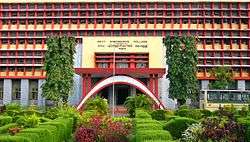
Already known as the Cultural Capital of Kerala, it is also fast developing as an education hub.[109][110] The city has traditionally been a centre of learning from ancient times. With the decline of Buddhism and Jainism and due to the growing supremacy of Brahminism during the revival of Hinduism, the City became an important centre of Sanskrit learning.[111][112] Schools in city are either run publicly by the Kerala Government or privately, some with financial aid from the Government. The medium of education is either English or Malayalam, with the former being the majority. Most schools are affiliated with the Kerala State Education Board or Indian Certificate of Secondary Education (ICSE) or the Central Board for Secondary Education (CBSE) or the National Institute of Open Schooling (NIOS) or the Montessori system.[112][113] There are 93 lower primary schools; 34 upper primary schools;[114][115] and 78 high schools;[116] and 157[117] higher secondary schools in the city.
With universities like Kerala Kalamandalam, Kerala Police Academy, Kerala Agricultural University, Kerala University of Health Sciences, National Research Institute for Panchakarma, Cheruthuruthy and Kerala Institute of Local Administration, the city would add another feather in its crown by having 'World Class University' and a 'Science City'. The Raj Kovu institute of Agriculture was made in 2012 to teach farmers about modern techniques of agriculture and better farming practices. The college currently has 300 students.[118][119][120] With three medical colleges, Government Medical College, Thrissur, Jubilee Mission Medical College and Research Institute, Amala Institute of Medical Sciences and Kerala medical university, the city has become synonymous with medical education in Kerala The district has two Kendriya Vidyalayas. Institute of cost Accountants of India (Statutory Body) have Thrissur Chapter located TC 37, CMA Bhawan, 1879/1, Kottappuram Rd.
Healthcare
The city serves as a centre for healthcare in the Central Kerala. The portion covers Thrissur District, Palakkad District, Malappuram District and northern part of Ernakulam District. Most of the people in these districts come to city of Thrissur for their medical care. There are three medical colleges, Government Medical College, Thrissur, Amala Institute of Medical Sciences and Jubilee Mission Medical College and Research Institute, and few other hi-tech hospitals.
The city has an ancient tradition of Ayurvedic treatment. From the Ashtavaidya tradition, Oushadhi, Vaidyaratnam Oushadhasala, Sitaram Ayurvedic Pharmacy Ltd and SNA Oushadhasala is located in city of Thrissur,[66] All these firms have been instrumental in spreading the fame of Kerala Ayurvedic treatment, as thousands of overseas patients visit the Ayurvedic treatment facilities in and around Thrissur, every year. Vaidyaratnam runs a medical college and Chikitsalayam, with global standards. Sitaram have a 100 bedded eight storied super speciality hospital in the city of Thrissur, envisaged as the first of its kind Ayurveda super speciality hospital in the country.[66]
An index case of COVID-19 was reported in Thrissur from a student in Wuhan University returning from Wuhan on 30 January 2020 and has since recovered.[121][122]
Sports
Football is the most popular sport in the city, and there are two football stadiums in the city, Thrissur Municipal Corporation Stadium and Thope Stadium. International players and former Indian captains C. V. Pappachan, I. M. Vijayan and Jo Paul Ancheri, the young Under 17 World Cup player K. P. Rahul belongs to Thrissur. The N.I. David Memorial Trophy, an annual inter-club football tournament is held in Thrissur every year. The football championship was started in 1996 by the then Superintendent of Police, Thrissur.[123][124][125][126][127] The city has a floodlit stadium, known as Thrissur Municipal Corporation Stadium.[128] It also has two indoor stadiums, V.K.N. Menon Indoor Stadium and a Sports Authority of India (SAI) maintained Thrissur Aquatic Complex with international facilities. Thrissur has contributed many national and international bodybuilding stars to India such as TV Poly and VM Basheer.[128] Chess prodigy Nihal Sarin is from Thrissur.
Media
The first Malayalam newspaper which published from Thrissur was Lokamanyan in 1920. Then came Deenabandhu edited by V. R. Krishnan Ezhuthachan. Ezhuthachan started publishing as a weekly in 1941 from Thrissur. It was one of the first periodicals that supported the national movement. As soon as the Quit India movement was started, its editor and staff were sent to jail and publications were banned.[129] Later Lokamanyan (1920); Kerala Chintamani (1905); Kerala Kesari (1924); Mahatma (1930); Gomathy (1930) and Navajeevan of Joseph Mundassery was also published from Thrissur.[130][131][132]The Express started in 1944 from Thrissur with K Krishanan as the editor is known in Central Kerala for its nationalist and socialist views.[129] Major Malayalam newspapers published in Thrissur include Malayala Manorama, Mathrubhumi, Madhyamam, Deepika, Kerala Kaumudi, Deshabhimani, Mangalam, Veekshanam, Metro Vaartha and Janayugom. A number of evening papers, like General in Malayalam and City Journal in English, are also published from the city. Newspapers in other regional languages like Hindi, Kannada, Tamil and Telugu are also available in city.
The first cinema hall in Kerala, with a manually operated film projector, was opened in Thrissur by Jose Kattookkaran in 1907. In 1913, the first electrically operated film projector was established in city again by Jose Kattookkaran and was called the Jose Electrical Bioscope now known as Jose Theatre.[133][134][135]
A film festival, known as ViBGYOR Film Festival, is held in the city every year. It is an international short and documentary film festival. Telephony services are provided by various players like Aircel, Airtel, Idea cellular, Vodafone, Reliance Infocomm, Tata Docomo, MTS, Uninor, Tata Indicom and the state owned BSNL. BSNL is also offering 3G services in Thrissur.[136] The city also have Broadband wireless services on WiMAX platform.[137][138]
Private FM radio stations in the Thrissur are Club FM 104.8 MHz, Radio Mango 91.9 MHz,[139] BEST FM 95 by (Asianet Communications Limited), Red FM 91.1 MHz.[140] All India Radio has an AM (630 kHz) and an FM (101.1 MHz) station for the city.[141] The transmitter of the All India Radio (630 kHz) was commissioned on 4 November 1956. The station started independent broadcasting in 1974.[142][143] Thrissur has a Doordarshan studio with a low power transmitter located near the studio.[144][145][146]
Tourism Circuit Tourism
2017 is being celebrated by the United Nation Organisation as the year of sustainable development of tourism. Keeping this in mind, DTPC, Thrissur, under the department of tourism, Kerala has launched Tourism Circuits all across the District, with a view to promote and uplift these cherished hopes. In order to full fill the goals, six (06) Tourism Circuits have been formed in Thrissur District, namely,
- Blue Circuit
- Brown Circuit
- Yellow Circuit
- Orange Circuit
- Green Circuit
- Red Circuit
These circuits were conceptualised by the Assistant Collector Under Trainee Mr. M.V.R Krishna Teja IAS under the aegis of the District Collector Dr. A. Kowsigan IAS. They were inaugurated by the Honb Minister of Industries Sri A.C. Moideen and Honb Agriculture Minister Sri V.S. Sunil Kumar on 7 April.
Picture gallery
- Entrance gate of Thrissur Zoo
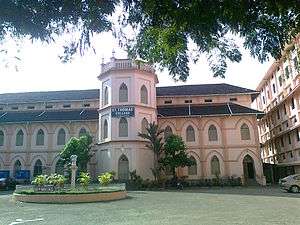

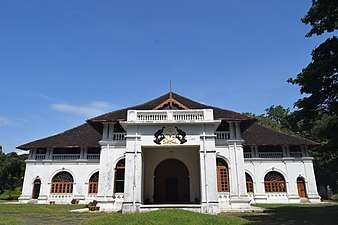
See also
References
- http://www.corporationofthrissur.org/general-information
- "Thrissur City" (PDF). Census2011. Retrieved 3 November 2011.
- "PROVISIONAL POPULATION TOTALS, CENSUS OF INDIA 2011" (PDF). Census India. Retrieved 28 October 2011.
- "COMPARATIVE STUDY OF DECADAL GROWTH OFSTATE/DISTRICTS 1991–2001, 2001–2011" (PDF). Census India. Retrieved 28 October 2011.
- "Districts Profile". Thrissur District. Archived from the original on 16 June 2011. Retrieved 22 September 2010.
- "Thousands witness Thrissur pooram". Thiruvananthapuram. 13 May 2019.
- The Indian Encyclopaedia. Books.google.com. 2002. ISBN 9788177552577. Retrieved 20 January 2013.
- "THRISSUR – HISTORY". Thrissur district website. Archived from the original on 23 February 2014. Retrieved 15 April 2014.
- "Thrissur". Thrissur Municipal Corporation. Archived from the original on 12 July 2012. Retrieved 22 September 2010.
- "Literary and cultural societies". Kerala Government. Archived from the original on 18 February 2012. Retrieved 6 October 2010.
- "Festivals and Fairs of Thrissur". Kerala Government. Archived from the original on 13 March 2014. Retrieved 6 October 2012.
- "Tourism". Thrissur Corporation. Archived from the original on 26 March 2012. Retrieved 6 October 2010.
- "Pilgrimage". Thrissur Corporation. Archived from the original on 26 March 2012. Retrieved 6 October 2010.
- T.K. Joseph (1955). Six St. Thomases of South India. University of California. p. 27.
- "Nasrani Syrian Christians". Kuzhippallil.com. Archived from the original on 4 July 2009. Retrieved 17 January 2010.
- "Catholic Syrian: God's Own Bank". Forbes India. Retrieved 27 April 2010.
- "World's second oldest mosque is in India". Bahrain tribune. Archived from the original on 6 July 2006. Retrieved 9 August 2006.
- "Cheraman Juma Masjid A Secular Heritage". Islamicvoice.com. Retrieved 20 January 2013.
- "Hindu patron of Muslim heritage site". iosworld.org. Retrieved 9 August 2006.
- "Kalam to visit oldest mosque in sub-continent". The Hindu. Chennai, India. 23 July 2005. Retrieved 9 August 2006.
- "South Indian Bank sees sunshine in slowdown". The Economic Times. 4 March 2009. Retrieved 16 February 2010.
- "Banking/Finance". (The Economic Times). 4 March 2009. Retrieved 14 July 2009.
- https://www.thehindubusinessline.com/money-and-banking/with-rbi-nod-esaf-is-now-scheduled-bank/article25853930.ece
- "Chit fund cos on the rise in Kerala". The Indian Express. Retrieved 15 February 2010.
- "Tourist statistics" (PDF). Kerala Tourism. Retrieved 15 February 2010.
- "History". Kerala Agricultural University. Archived from the original on 17 March 2014. Retrieved 6 May 2010.
- "About Us". Kerala Institute of Local Administration. Archived from the original on 16 October 2013. Retrieved 6 May 2010.
- "Educational Institutions". Thrissur Corporation. Archived from the original on 26 March 2012. Retrieved 6 October 2010.
- "A tour of heritage sites in Thrissur". The Hindu. Chennai, India. 4 December 2009. Retrieved 9 July 2010.
- S Hemachandran, "Monuments Embossing History", Kerala Calling, July 2007. Retrieved 24 January 2009
- V V K Valath (1992). Keralathile Sthalacharithrangal: Thrissur Jilla,(Malayalam: കേരളത്തിലെ സ്ഥലചരിത്രങ്ങൾ: തൃശ്ശൂർ ജില്ല) p.217. Kerala Sahithya Akadamy, Thrissur.
- "Students prepare manual on flora". The Hindu. Chennai, India. 4 March 2005. Retrieved 9 July 2010.
- "Brief History" (PDF). Kerala Government. Archived from the original (PDF) on 26 April 2012. Retrieved 27 June 2011.
- "History". St. Anthony's Forane Church. Archived from the original on 6 October 2011. Retrieved 27 June 2011.
- "Tipu Sultan: as known in Kerala". VOI Books. Retrieved 27 June 2011.
- "Thrissur school remembers Mahatma's visit". The Hindu. Chennai, India. 15 October 2010. Retrieved 11 July 2011.
- "Barrister Krishna Menon's forgotten story". CityJournal. Archived from the original on 23 September 2015. Retrieved 11 July 2011.
- C A Krishnan (2009). Anchuvilakku, p.35-38. Green Books, Thrissur. ISBN 978-81-8423-128-1
- "Thrissur – History". Thrissur Govt. Archived from the original on 26 October 2011. Retrieved 11 July 2011.
- "A Leader par excellence". ScrollIndia. Archived from the original on 9 February 2011. Retrieved 11 July 2011.
- "Karunakaran passes away, bringing curtains down on era in Kerala politics". The Economic Times. 23 December 2010. Retrieved 11 July 2011.
- "Officials recount Thrissur stories". Business Line. Archived from the original on 13 June 2013. Retrieved 11 July 2011.
- "Geography and Climate" (PDF). ADB. Archived from the original (PDF) on 12 June 2012. Retrieved 16 May 2010.
- "Warning bells in Kole". The Hindu. Retrieved 23 June 2012.
- "Agriculture-wetland interactions and sustainability of rice cultivation in the Kole land, Kerala" (PDF). Jeena T Srinivasan. Retrieved 23 June 2012.
- "Project to protect kole wetlands". The Hindu. Retrieved 23 June 2012.
- "Migratory fish spotted in kole land". The Hindu. Retrieved 23 June 2012.
- Jose AI, Paulose S, Prameela P & Bonny BP (eds), 2002, Package of Practices Recommendations: Crops Archived 19 December 2005 at the Wayback Machine, Kerala Agricultural University. Retrieved 18 January 2006.
- "Geography". Thrissur Municipal Corporation. Archived from the original on 26 April 2012. Retrieved 27 November 2010.
- "Climate". Kerala Government. Archived from the original on 8 February 2011. Retrieved 22 September 2010.
- "Kerala shines in gold ornament export". The Economic Times. 20 August 2005. Retrieved 13 December 2010.
- "No impact of recession on gold business'". Business Line. Retrieved 13 December 2010.
- "Kerala Hosts First Gem & Jewellery Show". Diamonds Net. Retrieved 13 December 2010.
- "Exhibition on gold jewellery from November 14". The Hindu. Chennai, India. 6 October 2008. Retrieved 13 December 2010.
- "ESAF to start with 10 branches as small finance bank". The Hindu. Retrieved 18 July 2016.
- "About Us". South Indian Bank. Retrieved 1 February 2010.
- "Genesis". Catholic Syrian Bank. Archived from the original on 17 February 2010. Retrieved 15 February 2010.
- "Chit fund companies on the rise". DNA. Retrieved 15 February 2010.
- "Chit fund cos on the rise in Kerala". The Indian Express. Retrieved 15 February 2010.
- "Thrissur – The nerve-centre of Ayurveda". Pharmabiz.com. Retrieved 13 December 2010.
- "Centre to part-fund Ayurveda testing facility in Thrissur". The Financial Express. Retrieved 13 January 2010.
- "Centre sanctions Rs 29 cr for ayurveda cluster in Thrissur". Business Line. Archived from the original on 23 March 2010. Retrieved 13 January 2010.
- "Thrissur – The nerve-centre of Ayurveda". Pharmabiz.com. Retrieved 13 January 2010.
- "Ayurvedic Industry – Challenges And Opportunities" (PDF). CII. Retrieved 13 January 2010.
- "Ayurveda Sector in India: Challenges, Potential & Way Forward" (PDF). Global Ayurveda Summit 2010. Retrieved 13 January 2010.
- "Thrissur – The nerve-centre of Ayurveda". Pharma biz. Retrieved 18 May 2010.
- "Thrissur, the new textile capital". Manorama Online.com. Retrieved 25 November 2010.
- "Koratty IT park set to begin operations". Business Standard. Retrieved 19 May 2010.
- "InfoPark Thrissur". Kerala IT. Archived from the original on 6 July 2010. Retrieved 19 May 2010.
- "Koratty Infopark first phase inauguration on Oct". The New Indian Express. 8 October 2009. Retrieved 19 May 2010.
- "Thrissur City Corporation turns 100". Malayala Manorama. Retrieved 27 October 2010.
- "History". Thrissur Corporation. Archived from the original on 19 July 2010. Retrieved 5 April 2010.
- "DEMOGRAPHIC & AREA PARTICULARS OF URBAN LOCAL BODIES". Thrissur District. Archived from the original on 16 June 2011. Retrieved 22 September 2010.
- "Thrissur Corporation". Thrissur Municipal Corporation. Archived from the original on 20 July 2010. Retrieved 22 September 2010.
- "Urban Planning and Land Use Management" (PDF). ADB. Archived from the original (PDF) on 12 June 2012. Retrieved 12 November 2012.
- "T.N. Rugmani And Another vs C. Achutha Menon And Ors on 20 December, 1990". Indiankanoon.org. Retrieved 12 November 2012.
- "Reinstatement of Thrissur Urban Development Authority" (PDF). Kerala Government. Retrieved 12 November 2012.
- "TUDA is back". Manoramaonline.com. Retrieved 12 November 2012.
- "Thrissur to have city police commissionerate". The Hindu. Chennai, India. 2 March 2011. Retrieved 24 June 2011.
- "Probe ordered into explosions". The Hindu. Chennai, India. 3 February 2011. Retrieved 24 June 2011.
- "Thrissur gets Police Commissioner". The Hindu. Chennai, India. 4 March 2011. Retrieved 24 June 2011.
- "Archived copy". Archived from the original on 1 January 2009. Retrieved 8 January 2009.CS1 maint: archived copy as title (link)
- "Central Prison, Viyyur" (PDF). Kerala Government. Retrieved 11 October 2010.
- "State security force soon". The Hindu. Chennai, India. 7 January 2011. Retrieved 3 February 2011.
- "29 more battalions for BSF". The Hindu. Chennai, India. 1 November 2009. Retrieved 3 February 2011.
- "More BSF facilities promised". The Hindu. Chennai, India. 28 January 2011. Retrieved 3 February 2011.
- http://www.censusindia.gov.in/2011census/C-01/DDW32C-01%20MDDS.XLS
- "NHAI report on four-lane work ready". The Hindu. Chennai, India. 7 September 2008. Retrieved 23 November 2010.
- "State govt to launch Puzhakkal mobility hub". Kerala, India: City journal. 14 August 2013. Archived from the original on 5 September 2013. Retrieved 2. Check date values in:
|accessdate=(help) - "Guruvayur-Tirunavaya rail line soon: Ahamed". The Hindu. Chennai, India. 12 August 2009. Retrieved 23 November 2010.
- "Ekm-Thrissur Memu to chug off today". The Times of India. Retrieved 12 July 2013.
- "Ernakulam-Thrissur MEMU from tomorrow". The Hindu. Retrieved 12 July 2013.
- "MEMU services to roll out in Thrissur". The Hindu. Retrieved 12 July 2013.
- "Lulu Convention Centre: Where occasions become events". Express Hospitality. Archived from the original on 10 July 2011. Retrieved 23 November 2010.
- "Lakhs witness Thrissur Pooram". The Hindu. Retrieved 2 February 2011.
- "Probe into Thrissur Pooram fireworks blast begins". The Hindu. Chennai, India. 6 May 2006. Retrieved 2 February 2011.
- "Hundreds of thousands converge as 'Thrissur Pooram' begins in Kerala". OneIndia. Retrieved 2 February 2011.
- "Caparisoned elephants steal the show at Thrissur Pooram". Sify News. Retrieved 2 February 2011.
- "Thousands feast on colourful Pulikali". The New Indian Express. 27 August 2010. Retrieved 12 September 2010.
- "'Tiger Dance' performed in Kerala". OneIndia. Retrieved 2 February 2011.
- "Yeddyurappa's elephant gift sparks row". The Hindu. Chennai, India. 7 November 2008. Retrieved 2 February 2011.
- "Thrissur elephants get a jumbo relief". DNA. Retrieved 2 February 2011.
- "Elephants in Kerala tuck into a jumbo feast". CNN. Retrieved 17 March 2010.
- "Elephants run amok at Thrissur and Guruvayur". Sify. Retrieved 17 March 2010.
- "When jumbos line up to solemnise a wedding". The Hindu. Chennai, India. 29 August 2005. Retrieved 17 March 2010.
- Ramavarman, T (23 September 2011). "Thrissur mourns its 'electric' corner". The Times of India. Retrieved 21 May 2020.
- http://www.thehindu.com/todays-paper/tp-national/tp-kerala/demolition-of-dilapidated-buildings-begins-in-thrissur/article2472410.ece
- "Thrissur mourns its 'electric' corner". The Times of India. 23 September 2011. Retrieved 10 December 2011.
- "Call to develop Thrissur as 'education destination'". The Hindu. Chennai, India. 12 February 2004. Retrieved 28 January 2011.
- "Thrissur set to become major education hub". The Hindu. Chennai, India. 11 November 2010. Retrieved 28 January 2011.
- "Educational Institutions". Thrissur Municipal Corporation. Archived from the original on 12 July 2012. Retrieved 22 September 2010.
- "Home". Thrissur Educational District. Retrieved 29 January 2011.
- "Home". DDE, Thrissur. Retrieved 29 January 2011.
- "Institutions". DDE Thrissur. Retrieved 29 January 2011.
- "List of UP schools in Thrissur District" (PDF). Kerala Government. Archived from the original (PDF) on 22 December 2009. Retrieved 29 January 2011.
- "List of High schools in Thrissur District" (PDF). Kerala Government. Retrieved 29 January 2011.
- "List of Schools". Kerala Government. Archived from the original on 21 July 2011. Retrieved 29 January 2011.
- "Charting a new course in education". The Hindu. Chennai, India. 24 January 2011. Retrieved 28 January 2011.
- "World class university to come up in Thrissur". The Hindu. Chennai, India. 7 September 2008. Retrieved 28 January 2011.
- "Ernakulam out of race for world class university". Chennai, India: Thrissur. 7 September 2008. Retrieved 28 January 2011.
- "Its back to study time for India's first COVID-19 patient from Thrissur". Mathrubhumi. Retrieved 9 May 2020.
- ThiruvananthapuramJanuary 30, P. S. Gopikrishnan Unnithan; January 31, 2020UPDATED:; Ist, 2020 12:16. "Kerala reports first confirmed coronavirus case in India". India Today. Retrieved 9 May 2020.CS1 maint: extra punctuation (link) CS1 maint: numeric names: authors list (link)
- "Inter-club football". The Hindu. Chennai, India. 26 December 2010. Retrieved 12 January 2011.
- "Football". Kerala Police. Archived from the original on 20 May 2011. Retrieved 12 January 2011.
- "Sudheesh fires in three". The Hindu. Chennai, India. 27 December 2010. Retrieved 12 January 2011.
- "Golden Threads posts win". The Hindu. Chennai, India. 31 December 2010. Retrieved 12 January 2011.
- "Aneesh shines". The Hindu. Chennai, India. 4 January 2011. Retrieved 12 January 2011.
- "Sports". Thrissur Municipal Corporation. Archived from the original on 12 July 2012. Retrieved 22 September 2010.
- "Media and political scenarios in Kerala" (PDF). Vidyanidhi.org. Archived from the original (PDF) on 21 July 2011. Retrieved 14 July 2010.
- "THE EVOLUTION OF PRESS IN KERALA" (PDF). Shodhganga. Retrieved 4 August 2014.
- "HISTORY OF PRESS IN KERALA". PRD. Archived from the original on 7 August 2014. Retrieved 4 August 2014.
- "Read history as the old newspapers reported". The Times of India. Retrieved 4 August 2014.
- "Cinema". Malayala Cinema.com. Retrieved 14 July 2010.
- "Hundred years of filial indifferenc". City Journal. Archived from the original on 4 October 2013. Retrieved 1 October 2013.
- "A true adventurer". The Hindu.
- "BSNL 3G services in Thrissur". The Hindu. Chennai, India. 17 January 2010. Retrieved 3 June 2010.
- "WiMax in Thrissur". Manoramaonline. Retrieved 3 June 2010.
- "BSNL launches WiMAX Services". BSNL. Archived from the original on 27 September 2010. Retrieved 3 June 2010.
- "Radio Mango Thrissur". Archived from the original on 12 March 2011. Retrieved 7 March 2011.
- "RED FM Thrissur". Kal Radio Limited. Retrieved 7 March 2011.
- "Thrissur radio stations". Asiawaves. Retrieved 3 September 2014.
- Address of AIR Station, Thrissur (Retrieved 8 January 2009)
- In euphonious harmony, The Hindu dated 3 February 2006
- "List of Doordarshan Studios". Ddindia.gov.in. Archived from the original on 20 January 2011. Retrieved 20 January 2013.
- "AIR Offices". Prasar Bharati. Retrieved 3 June 2010.
- "Doordarshan Kendra's". Prasar Bharati. Retrieved 3 June 2010.
Further reading
- C A Krishnan (2009), Anchuvilakku (Malayalam : അഞ്ചുവിളക്ക്). Green Books, Thrissur. ISBN 978-81-8423-128-1
- T. R. Venugopalan (2012), Sampathum Adhikaravum: Thrissuril Ninnulla Oru Kazcha, Cosmos Books, Thrissur. ISBN 978-81-226-0935-6
- Robert Bradnock, Roma Bradnock (2000), South India Handbook: The Travel Guide. ISBN 978-1-900949-81-1
- Sarina Singh (2001), South India. ISBN 978-1-86450-246-6
- Karen Schreitmüller (2009), India. ISBN 978-3-8297-6622-7
